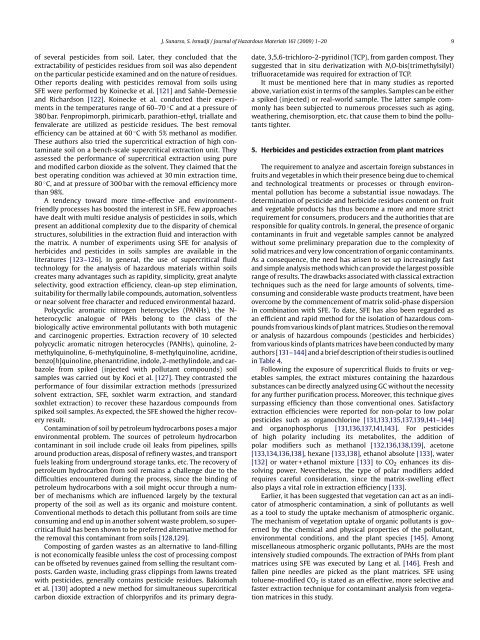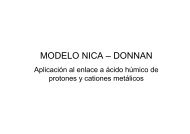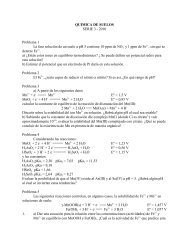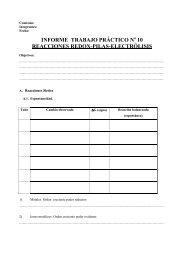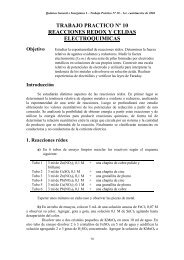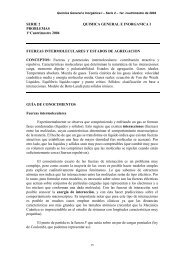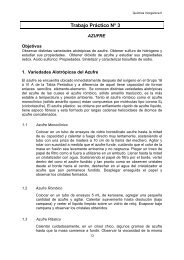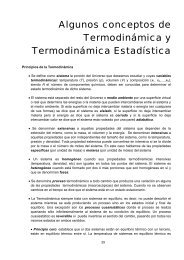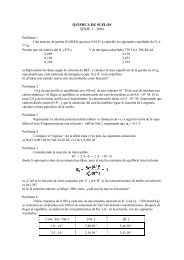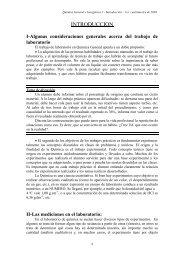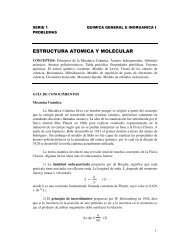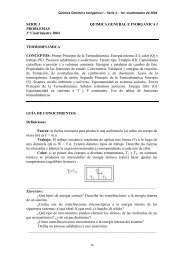Journal of Hazardous Materials Decontamination of hazardous ...
Journal of Hazardous Materials Decontamination of hazardous ...
Journal of Hazardous Materials Decontamination of hazardous ...
You also want an ePaper? Increase the reach of your titles
YUMPU automatically turns print PDFs into web optimized ePapers that Google loves.
J. Sunarso, S. Ismadji / <strong>Journal</strong> <strong>of</strong> <strong>Hazardous</strong> <strong>Materials</strong> 161 (2009) 1–20 9<strong>of</strong> several pesticides from soil. Later, they concluded that theextractability <strong>of</strong> pesticides residues from soil was also dependenton the particular pesticide examined and on the nature <strong>of</strong> residues.Other reports dealing with pesticides removal from soils usingSFE were performed by Koinecke et al. [121] and Sahle-Demessieand Richardson [122]. Koinecke et al. conducted their experimentsin the temperatures range <strong>of</strong> 60–70 ◦ C and at a pressure <strong>of</strong>380 bar. Fenpropimorph, pirimicarb, parathion-ethyl, triallate andfenvalerate are utilized as pesticide residues. The best removalefficiency can be attained at 60 ◦ C with 5% methanol as modifier.These authors also tried the supercritical extraction <strong>of</strong> high contaminatesoil on a bench-scale supercritical extraction unit. Theyassessed the performance <strong>of</strong> supercritical extraction using pureand modified carbon dioxide as the solvent. They claimed that thebest operating condition was achieved at 30 min extraction time,80 ◦ C, and at pressure <strong>of</strong> 300 bar with the removal efficiency morethan 98%.A tendency toward more time-effective and environmentfriendlyprocesses has boosted the interest in SFE. Few approacheshave dealt with multi residue analysis <strong>of</strong> pesticides in soils, whichpresent an additional complexity due to the disparity <strong>of</strong> chemicalstructures, solubilities in the extraction fluid and interaction withthe matrix. A number <strong>of</strong> experiments using SFE for analysis <strong>of</strong>herbicides and pesticides in soils samples are available in theliteratures [123–126]. In general, the use <strong>of</strong> supercritical fluidtechnology for the analysis <strong>of</strong> <strong>hazardous</strong> materials within soilscreates many advantages such as rapidity, simplicity, great analyteselectivity, good extraction efficiency, clean-up step elimination,suitability for thermally labile compounds, automation, solventlessor near solvent free character and reduced environmental hazard.Polycyclic aromatic nitrogen heterocycles (PANHs), the N-heterocyclic analogue <strong>of</strong> PAHs belong to the class <strong>of</strong> thebiologically active environmental pollutants with both mutagenicand carcinogenic properties. Extraction recovery <strong>of</strong> 10 selectedpolycyclic aromatic nitrogen heterocycles (PANHs), quinoline, 2-methylquinoline, 6-methylquinoline, 8-methylquinoline, acridine,benzo[h]quinoline, phenantridine, indole, 2-methylindole, and carbazolefrom spiked (injected with pollutant compounds) soilsamples was carried out by Koci et al. [127]. They contrasted theperformance <strong>of</strong> four dissimilar extraction methods (pressurizedsolvent extraction, SFE, soxhlet warm extraction, and standardsoxhlet extraction) to recover these <strong>hazardous</strong> compounds fromspiked soil samples. As expected, the SFE showed the higher recoveryresult.Contamination <strong>of</strong> soil by petroleum hydrocarbons poses a majorenvironmental problem. The sources <strong>of</strong> petroleum hydrocarboncontaminant in soil include crude oil leaks from pipelines, spillsaround production areas, disposal <strong>of</strong> refinery wastes, and transportfuels leaking from underground storage tanks, etc. The recovery <strong>of</strong>petroleum hydrocarbon from soil remains a challenge due to thedifficulties encountered during the process, since the binding <strong>of</strong>petroleum hydrocarbons with a soil might occur through a number<strong>of</strong> mechanisms which are influenced largely by the texturalproperty <strong>of</strong> the soil as well as its organic and moisture content.Conventional methods to detach this pollutant from soils are timeconsuming and end up in another solvent waste problem, so supercriticalfluid has been shown to be preferred alternative method forthe removal this contaminant from soils [128,129].Composting <strong>of</strong> garden wastes as an alternative to land-fillingis not economically feasible unless the cost <strong>of</strong> processing compostcan be <strong>of</strong>fseted by revenues gained from selling the resultant composts.Garden waste, including grass clippings from lawns treatedwith pesticides, generally contains pesticide residues. Bakiomahet al. [130] adopted a new method for simultaneous supercriticalcarbon dioxide extraction <strong>of</strong> chlorpyrifos and its primary degradate,3,5,6-trichloro-2-pyridinol (TCP), from garden compost. Theysuggested that in situ derivatization with N,O-bis(trimethylsilyl)trifluoracetamide was required for extraction <strong>of</strong> TCP.It must be mentioned here that in many studies as reportedabove, variation exist in terms <strong>of</strong> the samples. Samples can be eithera spiked (injected) or real-world sample. The latter sample commonlyhas been subjected to numerous processes such as aging,weathering, chemisorption, etc. that cause them to bind the pollutantstighter.5. Herbicides and pesticides extraction from plant matricesThe requirement to analyze and ascertain foreign substances infruits and vegetables in which their presence being due to chemicaland technological treatments or processes or through environmentalpollution has become a substantial issue nowadays. Thedetermination <strong>of</strong> pesticide and herbicide residues content on fruitand vegetable products has thus become a more and more strictrequirement for consumers, producers and the authorities that areresponsible for quality controls. In general, the presence <strong>of</strong> organiccontaminants in fruit and vegetable samples cannot be analyzedwithout some preliminary preparation due to the complexity <strong>of</strong>solid matrices and very low concentration <strong>of</strong> organic contaminants.As a consequence, the need has arisen to set up increasingly fastand simple analysis methods which can provide the largest possiblerange <strong>of</strong> results. The drawbacks associated with classical extractiontechniques such as the need for large amounts <strong>of</strong> solvents, timeconsumingand considerable waste products treatment, have beenovercome by the commencement <strong>of</strong> matrix solid-phase dispersionin combination with SFE. To date, SFE has also been regarded asan efficient and rapid method for the isolation <strong>of</strong> <strong>hazardous</strong> compoundsfrom various kinds <strong>of</strong> plant matrices. Studies on the removalor analysis <strong>of</strong> <strong>hazardous</strong> compounds (pesticides and herbicides)from various kinds <strong>of</strong> plants matrices have been conducted by manyauthors [131–144] and a brief description <strong>of</strong> their studies is outlinedin Table 4.Following the exposure <strong>of</strong> supercritical fluids to fruits or vegetablessamples, the extract mixtures containing the <strong>hazardous</strong>substances can be directly analyzed using GC without the necessityfor any further purification process. Moreover, this technique givessurpassing efficiency than those conventional ones. Satisfactoryextraction efficiencies were reported for non-polar to low polarpesticides such as organochlorine [131,133,135,137,139,141–144]and organophosphorus [131,136,137,141,143]. For pesticides<strong>of</strong> high polarity including its metabolites, the addition <strong>of</strong>polar modifiers such as methanol [132,136,138,139], acetone[133,134,136,138], hexane [133,138], ethanol absolute [133], water[132] or water + ethanol mixture [133] to CO 2 enhances its dissolvingpower. Nevertheless, the type <strong>of</strong> polar modifiers addedrequires careful consideration, since the matrix-swelling effectalso plays a vital role in extraction efficiency [133].Earlier, it has been suggested that vegetation can act as an indicator<strong>of</strong> atmospheric contamination, a sink <strong>of</strong> pollutants as wellas a tool to study the uptake mechanism <strong>of</strong> atmospheric organic.The mechanism <strong>of</strong> vegetation uptake <strong>of</strong> organic pollutants is governedby the chemical and physical properties <strong>of</strong> the pollutant,environmental conditions, and the plant species [145]. Amongmiscellaneous atmospheric organic pollutants, PAHs are the mostintensively studied compounds. The extraction <strong>of</strong> PAHs from plantmatrices using SFE was executed by Lang et al. [146]. Fresh andfallen pine needles are picked as the plant matrices. SFE usingtoluene-modified CO 2 is stated as an effective, more selective andfaster extraction technique for contaminant analysis from vegetationmatrices in this study.


